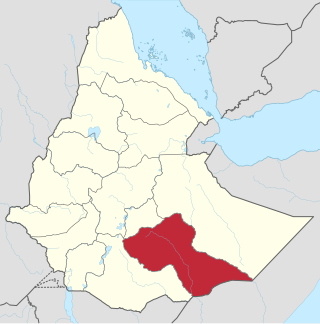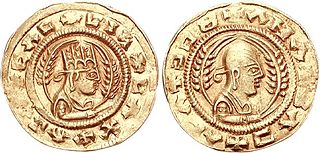Related Research Articles

Gudit is the Classical Ethiopic name for a personage also known as Yodit in Tigrinya, and Amharic, but also Isato in Amharic, and Ga'wa in Ţilţal. The person behind these various alternative names is portrayed as a powerful female ruler, probably identical to Māsobā Wārq, the daughter of the last Aksumite king, Dil Na'ad, mentioned in an early Arabic source. She is said to have been responsible for laying waste the Kingdom of Aksum and its countryside, and the destruction of its churches and monuments in the 10th century AD in revenge for the church having cut her breast off and selling her into slavery. If she is the same as the Tirda' Gābāz in other Ethiopian sources, she is also said to have attempted to exterminate the members of the ruling dynasty. The deeds attributed to her are recorded in oral tradition and in a variety of historical narratives.

Bale, also known as Bali, is the name of two former polities located in the southeastern part of modern Ethiopia.

The Zagwe dynasty was a medieval Agaw Orthodox Christian monarchy that ruled the northern parts of Ethiopia and Eritrea. The Agaw are a Cushitic ethnic group native to the northern highlands of Ethiopia and neighboring Eritrea. Centered at Roha, it ruled large parts of the territory from approximately 900 to 1270 AD, when the last Zagwe King Za-Ilmaknun was killed in battle by the forces of the Amhara King Yekuno Amlak. The Zagwe are most famous for their king Gebre Mesqel Lalibela, who is credited with having constructed the rock-hewn monolithic churches of Lalibela.

Amda Seyon I, also known as Amda Tsiyon I, throne name Gebre Mesqel was Emperor of Ethiopia from 1314 to 1344 and a member of the Solomonic dynasty.
Newaya Krestos was Emperor of Ethiopia from 1344 to 1372, and a member of the Solomonic dynasty. He was the eldest son of Amda Seyon I.
Dawit I was Emperor of Ethiopia from 1382 to 6 October 1413, and a member of the Solomonic dynasty. He was the younger son of Newaya Krestos.
Yeshaq I, throne name: Gabra Masqal II was Emperor of Ethiopia from 1414 to 1429/1430, and a member of the Solomonic dynasty. He was the second son of Emperor Dawit I.

Kaleb, also known as Saint Elesbaan, was King of Aksum, which was situated in modern-day Ethiopia and Eritrea

Aṣ-ḥamah also spelt as Aṣ-ḥama, was the Negus ruler of the Kingdom of Aksum who reigned from 614–630 C.E.. It is agreed by Muslim scholars that Najashi gave shelter to Muslim emigrants from Mecca, around 615–616 at Axum.

The Sultanate of Ifat, known as Wafāt or Awfāt in Arabic texts, or the Kingdom of Zeila was a medieval Sunni Muslim state in the eastern regions of the Horn of Africa between the late 13th century and early 15th century. It was formed in present-day Ethiopia around eastern Shewa in Ifat. Led by the Walashma dynasty, the polity stretched from Zequalla to the port city of Zeila. The kingdom ruled over parts of what are now Ethiopia, Djibouti and Somaliland.

Istifanos Monastery is a monastery in Ethiopia, located in Lake Hayq. The church structure was built around the 9th century by the Aksumite king Dil Na'od. In the 13th century the church was converted into a monastery in large part due to the work of Saint Iyasus Mo'a and later Emperor Yekuno Amlak.
Sa'ad ad-Din II, reigned c. 1386 – c. 1403 or c. 1410, was a Sultan of the Ifat Sultanate. He was the brother of Haqq ad-Din II, and the father of Mansur ad-Din, Sabr ad-Din II and Badlay ibn Sa'ad ad-Din. The historian Richard Pankhurst describes him as "the last great ruler of Ifat." He was of a Somali ethnic background.
Haqq ad-Din II was a Sultan of the Ifat Sultanate, the brother of Sa'ad ad-Din II, and the son of Ahmad ibn Ali.
Mara Takla Haymanot was King and the founder of the Zagwe dynasty. Some king lists give his name simply as "Mararah", and other King Lists as "Takla Haymanot".

The migration to Abyssinia, also known as the First Hijra, was an episode in the early history of Islam, where the first followers of the Islamic prophet Muhammad migrated from Arabia due to their persecution by the Quraysh, the ruling Arab tribal confederation of Mecca. They sought and were granted refuge in the Kingdom of Aksum, an ancient Christian state that was situated in modern-day Ethiopia and Eritrea, in 9 BH (613 CE) or 7 BH (615 CE). The ruling Aksumite monarch who received them is known in Islamic sources as Najashi, the Negus of the kingdom; modern historians have alternatively identified him with the Aksumite king Armah and Ella Tsaham. Some of the Sahabah exiles returned to Mecca and made the migration to Medina with Muhammad, while the others remained in Aksum and arrived in Medina in 628.
Degna Djan was an Emperor of the Kingdom of Aksum. Paul B. Henze states that his throne name was "'Anbasa Wedem", which tradition states was his oldest son's name. His younger son was Dil Na'od.

The ancient history ofYemen or South Arabia is especially important because it is one of the oldest centers of civilization in the Near East. Its relatively fertile land and adequate rainfall in a moister climate helped sustain a stable population, a feature recognized by the ancient Greek geographer Ptolemy, who described Yemen as Eudaimon Arabia meaning Fortunate Arabia or Happy Arabia. Between the eighth century BCE and the sixth century CE, it was dominated by six main states which rivaled each other, or were allied with each other and controlled the lucrative spice trade: Saba', Ma'īn, Qatabān, Hadhramaut, Kingdom of Awsan, and the Himyarite Kingdom. Islam arrived in 630 CE and Yemen became part of the Muslim realm.

The Kingdom of Aksum (Ge'ez: አኵስም ʾÄkʷəsəm; Sabaic: 𐩱𐩫𐩪𐩣ʾKS1M; Ancient Greek: Ἀξωμίτης Axōmítēs), also known as the Kingdom of Axum, or the Aksumite Empire, was a kingdom in East Africa and South Arabia from Classical antiquity to the Middle Ages. Based in what is now Northern Ethiopia and Eritrea, and spanning present day Djibouti and Sudan, it extended at its height into much of Southern Arabia during the reign of Kaleb, King of Axum.
Angot was a historical province in northern Ethiopia. It was bordered on the west by Bugna and the Afar lowlands to the east and southeast, Ambassel to the southwest and Lasta to the north.
Biqulzar also spelled as Baqulzar or Bequl zar was a historical region located in eastern Ethiopia. The state was positioned east of the Awash River. Historian Hussein Ahmed, proposes it was a general term for districts east of Amhara region in the fourteenth century.